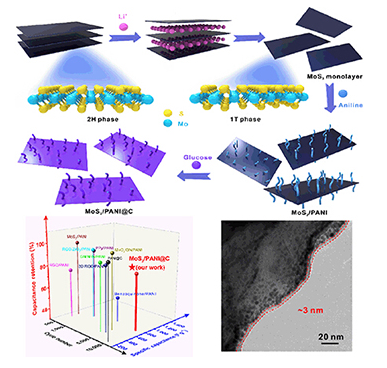Conducting polymers generally show high specific capacitance but suffer from poor rate capability and rapid capacitance decay, which greatly limits their practical applications in supercapacitor electrodes. To this end, many studies have focused on improving the overall capacitive performance by synthesizing nanostructured conducting polymers or by depositing a range of coatings to increase the active surface area exposed to the electrolyte and enhance the charge transport efficiency and structural stability. Despite this, simultaneously achieving high specific capacitance, good rate performance, and long cycle life remains a considerable challenge. Among the various two-dimensional (2D) layered materials, octahedral (1T) phase molybdenum disulfide (MoS2) nanosheets have high electrical conductivity, large specific surface areas, and unique surface chemical characteristics, making them an interesting substrate for the controlled growth of nanostructured conducting polymers. This paper reports the rational synthesis of carbon shell-coated polyaniline (PANI) grown on 1T MoS2monolayers (MoS2/PANI@C). The composite electrode comprised of MoS2/PANI@C with a -3 nm carbon shell exhibited a remarkable specific capacitance of up to 678 F·g–1(1 mV·s–1), superior capacity retention of 80% after 10,000 cycles and good rate performance (81% at 10 mV·s–1) due to the multiple synergic effects between the PANI nanostructure and 1T MoS2substrates as well as protection by the uniform thin carbon shell. These properties are comparable to the best overall capacitive performance achieved for conducting polymers-based supercapacitor electrodes reported thus far.
The work was published on Nano Research, see details:
Chao Yang, Zhongxin Chen, Imran Shakir, Yuxi Xu* and Hongbin Lu*, Rational synthesis of carbon shell coated polyaniline/MoS2 monolayer composites for high-performance supercapacitors, Nano Res., 2016, DOI: 10.1007/s12274-016-0983-3.
